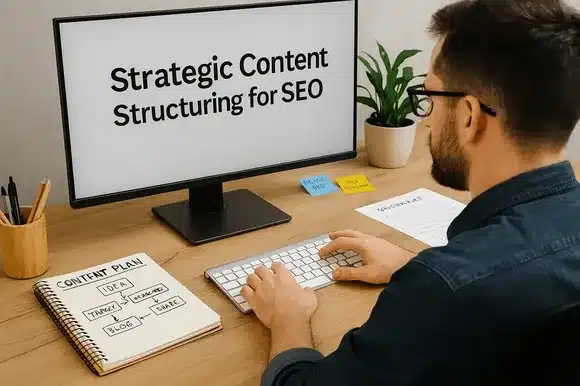SEO Article Template: Structure Content That Ranks
Every article I deliver follows a proven SEO framework built for structure, intent, and performance.

Ranking content isn’t about luck — it’s about structure. When you work with me, I use a strategic article framework designed to help your content compete in search, engage real readers, and drive results. Every word is planned with clarity, intent, and search visibility in mind.
Phase 1: Structured SEO Layout
Strong articles start with structure. That means more than just using keywords — it means organizing your message in a way that’s easy to read and easy to rank. I build each piece using a layout that satisfies both your audience and Google’s expectations, from top to bottom.
This structure makes it easier to connect ideas, support internal linking, and guide readers toward meaningful actions — whether that’s subscribing, exploring more, or contacting you directly.
Key layout elements I include:
- SEO-Focused Title & Subtitle: Your title targets the main keyword, while the subtitle adds depth and encourages clicks in search results.
- Meta Description: A concise, benefit-driven summary that naturally includes your primary keyword and entices readers to click.
- Introduction with a Hook: Clear, relevant, and fast-loading — the first paragraph sets expectations and grabs attention.
- Strategic H2/H3 Subheadings: Logical, scannable, and structured to support SEO while guiding the reader through each topic.
- Internal Linking Points: I build in natural linking opportunities to related content, pillar pages, or conversion assets.
- Call-to-Action Placement: At the right moment — never forced — to lead readers to the next logical step with purpose.
Optional additions: For longer pieces or mobile-heavy audiences, I may also add bulleted summaries or short orientation sections up top for faster navigation.
Why it works: Google prioritizes structure. Your readers do, too. A clean, well-organized article improves rankings, reduces bounce, and increases time on page — all without feeling stiff or overengineered.
Phase 2: Keyword & Intent Optimization

Good structure gets you noticed — strong keyword strategy gets you ranked. I research and integrate keywords based on how your audience searches, not just what you want to say. This includes both high-volume primary terms and semantically related keywords that expand your topical reach.
I align every section with the intent behind the search: informational, commercial, or navigational — ensuring your content meets expectations and ranks more consistently across variations.
What I include:
- Primary Keywords: Featured in key areas like the title, introduction, and headers — without overuse or unnatural repetition.
- Related & Long-Tail Terms: Naturally woven into the body to support semantic depth and capture more qualified traffic.
- Context Matching: I study search results and align phrasing to what’s currently ranking, while making your version stand out with clarity and completeness.
- Intent-Based Language: I use the terms and cues your audience expects — whether they’re looking to learn, compare, or decide.
What I avoid: Keyword stuffing, rigid phrasing, or forced optimization. Everything is written for humans first — with ranking as the outcome, not the starting point.
Why it works: Google now evaluates meaning, not just terms. By aligning your content with intent and context, I help it show up for a wider range of valuable searches.
Phase 3: Purpose-Driven Section Development

Every part of your article has a job to do — so I treat it that way. I develop each section individually to keep ideas sharp, flow smooth, and SEO signals focused. No filler, no generic fluff, and no rushed paragraphs crammed with vague phrasing.
My section-by-section process gives you:
- Clearer Messaging: Each idea gets the space it needs — nothing muddled or skipped over.
- Stronger SEO: I vary keyword usage by section, helping each part support a broader set of rankings.
- Logical Flow: Transitions guide the reader naturally from one idea to the next — no abrupt jumps or topic drift.
- Greater Precision: I can adjust tone, structure, or emphasis as needed — without compromising the bigger picture.
- Intentional Links: Internal references and supporting resources are placed where they make sense, not just added at the end.
Why it works: This method gives you control, clarity, and consistency — all of which improve performance, reader satisfaction, and search visibility.
Phase 4: Behavioral SEO & Engagement Triggers

It’s not enough to get a click — you need to keep attention. I optimize articles for behavior as much as search, using formatting cues and psychological hooks to increase scroll depth, dwell time, and overall engagement.
This turns casual visitors into active readers — and ultimately into leads, subscribers, or customers.
What I build in:
- Short Paragraphs & Strong Openers: Every section starts with immediate value and stays easy to read — especially on mobile.
- Bolded Key Points & Bullets: Helps users scan quickly and find what matters to them.
- Reflective Questions & Natural Transitions: Keeps readers moving without feeling like they’re being sold to.
- Internal Link Integration: Placed mid-article where they’re most helpful — not just tucked away at the end.
- Subtle CTAs: I guide readers to take the next step when it makes sense — no pressure, just clarity.
Why it works: Google tracks user engagement — and so do I. The more time someone spends with your content, the more signals you send that it’s worth ranking.
Bringing It All Together
Effective content doesn’t come from templates — it comes from strategy. I combine structured layout, refined keyword planning, and real human storytelling to deliver content that ranks and converts.
When I write your article, you get:
- SEO clarity that improves rankings without compromising tone
- Clear formatting that enhances readability across devices
- Behavioral optimization that encourages action, not just attention
- Full editorial control over the outcome — nothing is left to chance
There’s no automation here. No one-size-fits-all output. Just a focused process designed to bring your ideas to life — in a way that Google and your readers will both respect.
Want help applying this to your content strategy? I’d be happy to help. Let’s build something that actually performs.